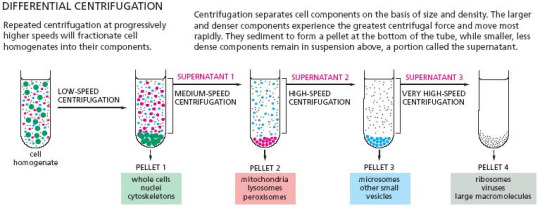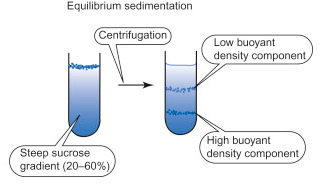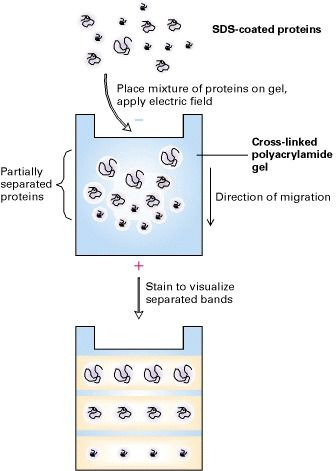#Equilibrium Density Gradient Centrifugation
Explore tagged Tumblr posts
Text
Pr and the Mniw
Pr is a minor planet orbiting the millisecond magnetar MMR CHA J1712-2901 ("Ast"), about a thousand light years from Earth, in the constellation Sagittarius. Ast has four major planets: Wsjrhp, Hrw, Mnw, and Bstt. Hrw has one moon, Jmstj. There are five large minor planet in eccentric orbits within 3 AU, Jrb, Bjr, Rrj, Zr, and Pr.
Planetoid
Pr is a large asteroid with a rotation period of about two hours; its average density is less than 4 g/cm^3, but its internal composition is highly variable. About 40% of its solid material is composed of massive diamond fragments fused together at seams formed of carbon glass, and the interior of the planet contains a large irregular cavern roughly 250 kilometers in radius. This cavern is sufficiently enclosed to retain an envelope of water and air with minimal outgassing. Due to the very high rotation speed of the planetoid, the surface of the cavern, at its lower levels, experiences a centrifugal force about 1-2% of Earth's gravity. The axis of Pr's rotation is nearly perpendicular to its orbit.
No complete model of the formation of the Ast system has yet been offered, but several hypotheses have been suggested to account for some of its more unusual features. The formation of a protoplanetary disk may be due to the disruption of a stellar companion, or fallback from the supernova that formed Ast in the first place; the diamond fragments which make up Pr may have originated in a disrupted carbon-rich planet or planetoid, or gas giant. The interior atmosphere of Pr is perhaps due primarily to biological processes releasing volatiles into the cavern.
Deliberate planetary engineering has been mooted as a possibility, but the crew of the DSE Scholiast, the only vessel to survey the system so far, has not yet found evidence of such engineering by other civilizations, and the indigenous inhabitants of Pr are likely incapable of such undertakings at this time.

[Map of Pr, with some regions and bodies of water labelled, plus many major settlements. The relief of the cavern interior is very great; the large plateaus have scarps tens or hundreds of kilometers high. Note that the equilibrium potential at the interior surface of a rotating body is cylindrical, not spherical, and this projection is adjusted accordingly, and so shows true shapes near the poles. The nature of the geological processes that have shaped Pr's interior are not fully understood at this time. The total land area visible here is roughly equivalent to Texas or the Iberian Peninsula.]
Biology and Ecology
Pr's internal heat is maintained by the radiation from Ast, which is converted to thermal energy in Pr's crust. Thinner regions of the crust, particularly near the equator, have higher heat flow from the exterior; the high axial tilt of Pr also means that the northern and southern hemispheres can experience somewhat different heat flows throughout the year. Much more important to Pr's seasons, however, is the variability of Ast's magnetic field created by the eccentricity of Pr's orbit. When Pr is closest to Ast, organisms can extract energy from the magnetic field, as Pr's rotation allows them to create selective ion gradients whose diffusion provides energy, or to directly extract mechanical energy from electrically charged cilia. (Induced current is much too weak to be a useful source of biological energy).
As on Earth, the native lifeforms can be broadly classified into producers and consumers, but even the consumers on Ast obtain a significant portion of their energy budget from autotrophy, using heterotrophy only to supplement this budget. A minority of producers are also radiotrophs, who extract energy from the radioactive elements in Pr's crust.
Pr biology does not use DNA and is highly resistant to radiation. It also does not seem to experience Darwinian genetic drift. Instead, cells seem able to adapt their own internal machinery in response to certain kinds of stress, and to disseminate these changes throughout the organism, or even to conspecifics. The nature of this process and how it could have evolved is still a mystery, nor can they apparently account for all of the different forms observed among the native life.
The interior of Pr is dim, but not dark. Some plant species have evolved to emit light as a form of signaling, incentivizing some animal species to evolve eyes in response.
Because of the energy inefficiency of pure heterotrophy, to say nothing of pure heterotrophy that involves predating on other heterotrophs, no carnivorous animals are known on Pr.

[Above, the Mniw. The upper Mni has a fully-grown set of skin-plates; the lower Mni has either shed or removed hers, possibly as a cosmetic choice. The dark patches of skin shown are the rough beds from which the skin-plates grow.]
The Mniw
The Mniw (singular Mni) are the indigenous inhabitants of Pr. They are 12-18 centimeters long, with tough gray skin, and usually found with a mineralized defensive covering that grows out from the skin. They have a single sex, and reproduce via parthenogenesis. However, they still engage in a form of sexual intercourse, which is divorced from reproduction: instead, sex among the Mniw exists as a means of facilitating horizontal gene transfer, which then alters the nature of the offspring they bear. It can also allow a limited sharing of experiential memory. In addition to sight, hearing, and the other usual senses, the Mniw have the ability to sense the weak induced electrical currents in Pr's crust, which helps them perceive their environment better.
Mniw hatch from eggs and are generally raised in family units; they do not make sex-based distinctions, but do make social distinctions based on relationships. A mwt is the Mni who laid the egg; all other adults in the same household involved in childrearing are jtw; the sntw are siblings who share a mother, while other children raised in the same house are snw. Children from one's own eggs are srtw, while children from one's partner(s) are mnw.
As in humans, Mni adolesence is marked by gradual sexual maturity; reproductive fertility comes later in life, however, around the age of 30. Past 50, fertility declines slowly, as does the capacity to engage in horizontal gene transfer, though the capacity for sexual intercourse remains. Past 65 or so, Mniw enter their equivalent of "old age," but Mni do not experience a sudden collapse in their physiological health late in life, and can in principle life forever so long as they are not felled by accident, violence, or disease. In practice, lifespans are around 130-200 years, with a great deal of variability.
Mniw have many social elements, like hierarchy and emotions and social roles, that would not be entirely alien to humans, but they have no direct analogue to human sex roles or orientations. Instead the major cleavage in Mni society historically is between Mniw who tend to be primarily exogamous, preferring to mate and rear children with Mniw from distant communities, vs Mniw who tend to be primarily endogamous, with about 85% of Mniw being primarily endogamous; these traits perhaps evolved in the context of horizontal gene transfer to take advantage of different patterns of dissemination of useful traits.
Mniw can survive outside of Pr, but without a strong, moving magnetic field must consume a large amount of food; and the food they are normally adapted for will not grow at all absent such a field. An Earth-standard gravitational field would render them totally immobile, and would be extremely unpleasant, though probably not fatal, and it's possible given their unique physiology that they could eventually adapt to such an environment.
Mniw generally inhabit large, almost hive-like cities that are built out in three dimensions; historically, these could be strongly fortified against attack in a way that made wars of conquest nearly impossible until the invention of gunpowder. Mniw have had writing for about 5,000 years, and the first confederate states emerged around 3-4,000 years ago. The dissemination of gunpowder weapons 1,500 years ago radically altered politics and society on Pr, but the absence of easy paths to industrialization has caused a certain degree of stagnation since.
Modern Pr is divided into about a dozen large states, in an area of roughly 750,000 kilometers square, with a fair amount of diversity in languages, cultures, and social systems, given the small size of Pr. A very loose framework of international diplomacy is carried out through a series of councils called the Jaw Mwad, and on the occasion of the Scholiast's arrival, the Mniw convened a great council, a Wr Jaw Mwad, for the first time in over a century to open formal channels of communication.
#tanadrin's fiction#speculative evolution#speculative biology#tanadrin's art#pr and the mniw#conworlding#life on a pulsar planet
60 notes
·
View notes
Link
Equilibrium Density Gradient Centrifugation | Cell Biology Technique | CSIR NET Life Sciences
1 note
·
View note
Text
How Do We Analyze Cell Membranes?
Organelles have very unique and distinct membrane composition from each other in the cell, so if we wish to analyze them separately, how can we achieve this?
First, we need to figure out how to separate the membranes from the organelles themselves. And in cell biology, there are quite a few techniques we can use to do this.
Before we can separate cell components based on their size, density, or protein composition, we first need to homogenize the cells. Homogenization is typically a very gentle mechanical procedure that breaks up the cells, however the membranes, nuclei and organelles stay intact. (The exception is the endoplasmic reticulum, due to its large size.) This can be done in a variety of ways, such as high frequency sound, using mild detergents, or physically lysing the cell mechanically.

Following this, there are a few methods of separating the cell components depending on what factor of separation you are aiming for.
Differential centrifugation is where the cell components are separated in different fractions by spinning the fractions at different speeds for different amounts of time. This technique does not separate the organelles to purity, as the various fractions are separated on their various sizes. As such, cell components that are of similar size, for example mitochondria, lysosomes and peroxisomes, will all end up in the same fraction.

Velocity centrifugation, also known as rate-zonal sedimentation, separates organelles based on their different sizes and relative masses. A cell homogenate would be poured as a thin layer over top a shallow sucrose gradient (5-20%), and centrifuged as such so larger organelles sink to the bottom of the fraction faster than the smaller organelles. The resulting fractions would be collected at the bottom of the tube.

Equilibrium density centrifugation is a technique where recovered organelles are separated based on their different densities. Similar to velocity centrifugation, the sample would be added to a gradient. However the sucrose gradient is much steeper (20-70%) and the homogenate would not be poured as a thin layer, but instead mixed in with the gradient. The fraction would then be centrifuged to equilibrium, and the low density components would collect higher on the fraction, and the higher density components would collect near of the bottom of the fraction.

And lastly, there is also immuno-isolation. Instead of spinning the cell fractions by size, the fractions would be mixed with targeted antibodies coated with protein-A beads. Protein-A is a bacterial protein that binds and sticks to antibodies, and as such is used as a tool that marks targeted organelles that antibodies stick to. The beads can then be recovered by centrifugation, and the targeted proteins can be analyzed.

Once the targeted components are isolated, we can analyze them. Depending on the type of analysis, we can test a variety of characteristics about cell membranes, like their lipid composition, properties, cytoskeleton, and protein-protein interactions. However one of the most common methods of protein analysis is SDS gel electrophoresis.
The isolated proteins would essentially be denatured with SDS and heat, and loaded on a gel with a running voltage. Because the proteins treated with SDS have a negative charge, they are pulled through the gel towards the positive electrode. The smaller proteins will migrate through the gel faster, and be closer to the bottom of the gel. Afterwards we can visualize and analyze the proteins via staining with Coomassie blue or autoradiography.


4 notes
·
View notes
Link
The global market size of Cesium chloride is $XX million in 2018 with XX CAGR from 2014 to 2018, and it is expected to reach $XX million by the end of 2024 with a CAGR of XX% from 2019 to 2024. There are 3 key segments covered in this report: geography segment, end use/application segment, and competitor segment. For geography segment, regional supply, application-wise, and type-wise demand, major players, price is presented from 2013 to 2023. This report covers the following regions: * North America * South America * Asia & Pacific * Europe * MEA (the Middle East and Africa) The key countries in each region are taken into consideration as well, such as United States, China, Japan, India, Korea, ASEAN, Germany, France, UK, Italy, Spain, CIS, and Brazil, etc. For end use/application segment, this report focuses on the status and outlook for key applications. End users sre also listed. * Application I * Application II * Application III For competitor segment, the report includes global key players of Cesium chloride as well as some small players. The information for each competitor includes:
#cesium chloride coordination number#equilibrium density gradient centrifugation#gradient centrifugation protocol
0 notes
Text
Centrifuge tube automatic production line - three centrifugation methods
Centrifuge tube automation production line solution manufacturers know three commonly used centrifugation methods: differential centrifugation; rate zonal centrifugation; isopycnic zonal centrifugation.

1. Differential centrifugation method
Differential centrifugation is often used in the extraction of crude products of biochemical samples. The difference in the sedimentation coefficient of different suspended particles in the centrifugal force field is used. Under the same centrifugal condition, different particles have different sedimentation velocities. By continuously increasing the relative centrifugal force, a non-uniform mixed liquid Particles of various sizes and shapes in the dispersed system settle in layers.
During the operation, the supernatant and the precipitate are generally separated after the first stage of centrifugation, and then the supernatant is centrifuged at a higher speed to separate the second part of the precipitate, and the speed is increased step by step in this way. The desired material is isolated. The resolution of differential centrifugation is not high, and various particles with sedimentation coefficients in the same order of magnitude are not easy to separate, so it is often used for crude product extraction of biochemical samples.
2. Velocity zone centrifugation
Velocity zonal centrifugation is an incomplete sedimentation separation. The sedimentation effect is greatly affected by the physical scale of the substance itself. It is generally used in the case where the materials have different sizes but the same density. It means that according to the centrifugal force of the particles to be separated, Due to the difference in the sedimentation velocity in the gradient liquid, the particles with different sedimentation velocities are in different density gradient layers after centrifugation, forming several separate sample zones to achieve the purpose of separation from each other.
For example, to separate mononuclear cells from venous blood, the former separation fluid Ficoll divides all mononuclear cells (lymphocytes and monocytes) in the blood into one layer and extracts them at the same time. The Percoll separation fluid divides the lymphocytes and monocytes in the blood into two gradient layers and extracts them separately. The gradient solution acts as a support medium and stabilizer during and after centrifugation to avoid resuspension of layered particles caused by mechanical vibration.
When using the rate zonal centrifugation method, the centrifugation time needs to be strictly controlled, not only to have enough time for various particles to form a zone in the medium gradient liquid, but also to avoid any particle to be separated from forming a precipitate state.

3. Isodensity zonal centrifugation
Isodensity zonal centrifugation means that when there is a difference in buoyancy density of different particles in the liquid dispersion system, under the centrifugal force field, the particles either settle down or float up, and move along the gradient to the position where their densities are exactly equal, that is, equal Density points, centrifugation method to form zones.
The centrifugation effect of isopycnic zonal centrifugation depends on the buoyant density difference of the particles. The larger the density difference, the better the separation effect, regardless of the size and shape of the particles, but the latter two determine the speed, time and zone of equilibrium. width.
The characteristics of the isopycnic zonal centrifugation method: It is related to the density of the sample particles; it has nothing to do with the size of the sample particles and other parameters; if the rotation speed and temperature remain unchanged, even if the centrifugation time is prolonged, the banding positions of these particles cannot be changed.
0 notes
Text
Separation of mouse testis cells by equilibrium density centrifugation in Renografin gradients
http://dlvr.it/P6DQJk
0 notes
Text
Separation of mouse testis cells by equilibrium density centrifugation in Renografin gradients
http://dlvr.it/P668np
0 notes